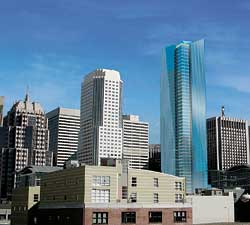The Art and Science of Peace and Quiet
Learning Objectives:
- Discuss techniques for mitigating external noise infiltration.
- Describe window assemblies designed for noise reduction.
- Discuss a low-tech way of reducing internal noise.
Credits:
Whether low or high frequency, man-made or natural, noise is the bane of modern living. It's easier to seal a building against water infiltration than the unwanted and disruptive sounds of the modern city-trains, planes, automobiles, jackhammers, horns, and sirens-that seep insidiously through walls and collide with windows, rattling their frames and driving inhabitants crazy. Even people hermetically sealed in office buildings suffer from disruptive noises created from within-humming light fixtures and air handlers, distracting conversations, and ringing phones. This is the consequence of the space-maximizing, cost-effective, privacy-eliminating open office plan, which is standard for most speculative commercial developments that lease large floor plates. Cubicle dwellers ward off aural assaults by wearing earplugs or expensive, high-tech headphones. Their adaptability, while admirable, only highlights a problem that studies show undermines productivity.
So prevalent is noise in dense urban areas that some experts argue that it has become a public-health risk. At the very least, what is called environmental noise has achieved the dubious distinction of being labeled "pollution," keeping company with carbon monoxide and Volatile Organic Compounds (VOCs). In Charles M. Salter Associates' excellent primer Acoustics: Architecture, Engineering, the Environment (William Stout, 1998), Alan Rosen reports that the problem first attracted federal attention in the early 1970s when "the United States introduced federal legislation that mandated research on environmental noise and its effects on people. Much of the research," he notes, "was sponsored by the U.S. Environmental Protection Agency (EPA). This research led government agencies to require noise impact studies," which in turn led to the Noise Control Act of 1972.
|
Congress directed the EPA to publish scientific studies identifying the effects of different characteristics and levels of noise. It also directed the EPA to define acceptable levels under various conditions, which would protect public health and welfare with an adequate margin of safety.










